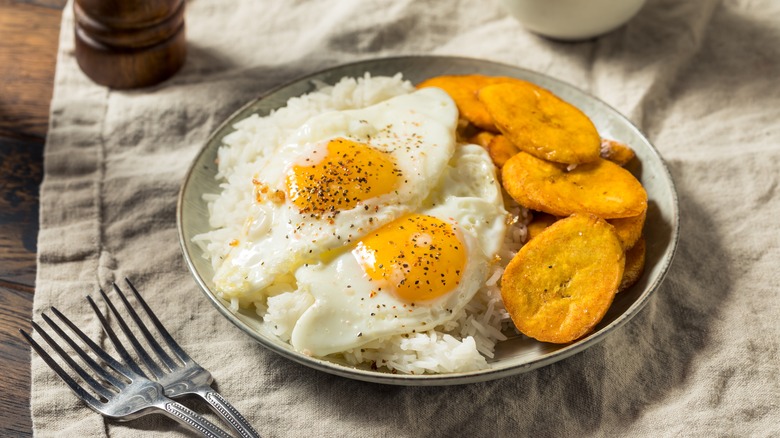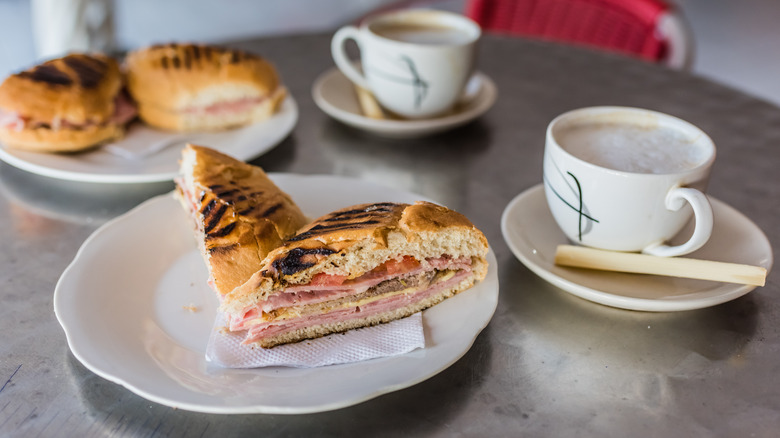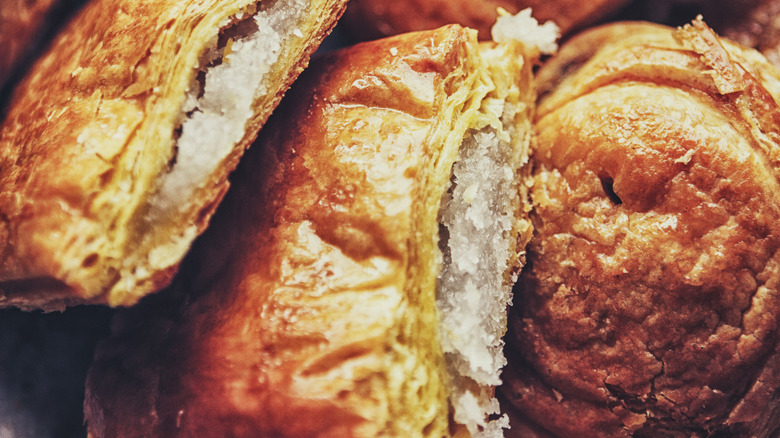Here's What Breakfast Might Look Like In Cuba
A years-long economic crisis triggered by the pandemic and facilitated by the strict trade restrictions imposed by the U.S. has left Cuba with a severe food shortage. However, the lack of supplies doesn't diminish the Latin American nation's rich culinary heritage. It offers plenty of dishes everyone must try at least once. Just with breakfast alone, Cuban cuisine presents different delicious ways to start the day. They range from simple to elaborate, from savory to sweet.
Certain essential elements must be present on every Cuban breakfast table. First is coffee, a staple beverage in the country. Cubans like their coffee strong and foamy, and they start their mornings with either one of these two types: cafe con leche, with the Cuban version similar to the Spanish one except for the addition of sugar, and cortadito, which is cafe Cubano with steamed milk added. The next essential is the soft pan Cubano that comes with a baguette-like crust. This can be eaten plain or spread with jam, and it's often pressed and slathered with butter for a richer flavor. The third essential is eggs, cooked either as tortillas with onions, garlic, and tomatoes; as slightly runny fried toppings on rice for a plate of arroz con huevos fritos; or as revoltillo de huevo, scrambled with onions, green peppers, tomatoes, and garlic.
These three items are the foundations of the typical Cuban breakfast, which you can build on to turn a basic meal into a bigger spread.
Enjoy coffee with a tasty pan Cubano
As a breakfast staple, pan Cubano is a testament to the Cubans' adaptability and ingenuity. According to University of South Florida associate librarian Andy Huse (via Taste Cooking), this long loaf was originally much shorter. French and Spanish culinary influences gradually led cooks to increase its measurement, however. There's also a widespread belief that as Cuba fought to gain independence from Spain towards the end of the 19th century, the war prompted locals to stretch the length of the bread so there'd be more portions available for rationing.
Pan Cubano's crackly crust, soft interior, and light sweetness make it great to eat on its own, but as we've mentioned, it's even better when spread with butter for pan de mantequilla or with the sweet and tangy guava jam. It can also be toasted to be the perfect vessel for a simple Cuban breakfast sandwich, with fried eggs, cheese, pickles, and slices of deli meat layered between two loaves. For something more decadent, there's pan con bistec, with thin slices of steak, onions, and the fragrant all-around mojo garlic sauce as the filling. The steak can be marinated in the same sauce, which combines the aromatic and savory garlic paste with bitter orange juice, cumin, and oregano. The meat is then pan-fried or grilled.
An interesting note about the pan Cubano: According to Huse, Cubans prefer to buy this from the bakery rather than make it at home, as encouraged by renowned Cuban chef, the late Nitza Villapol.
Add something sweet to the table
Cubans also enjoy having something sweet for breakfast. A plate of seasonal tropical fruits — papaya, bananas, and mangoes — is a simple but popular choice. There's also their version of French bread called torrejas. Bread is sliced into one-inch pieces and then soaked in a mixture of milk, sugar, vanilla extract, nutmeg, and cinnamon. It gets a second soak in a bowl of beaten eggs before being fried until it turns golden brown. Pan Cubano is perfect for this because its crust can withstand all that moisture.
Jams also serve as sweet highlights of a Cuban breakfast, with guava as a popular flavor in the country. It's often made by cooking down guava paste, a common ingredient in various Latin American cuisines made by boiling ripe guava pulp with sugar. It's also used as a filling for pastelitos de guayaba, a buttery, flaky pastry enjoyed during breakfast and as a snack. The bright red guava paste is mixed with cream cheese so its intense, fruity flavor is tempered by something rich and slightly salty.
Typically treated as dessert, arroz con leche or rice pudding can also be a filling breakfast. The Cuban version uses short-grain rice so it comes out thicker. The rice is cooked in water with a cinnamon stick and a lemon peel. Once all the water has been absorbed, the flavoring agents are removed and condensed milk gets stirred in. The dish is served with a sprinkling of cinnamon powder.


